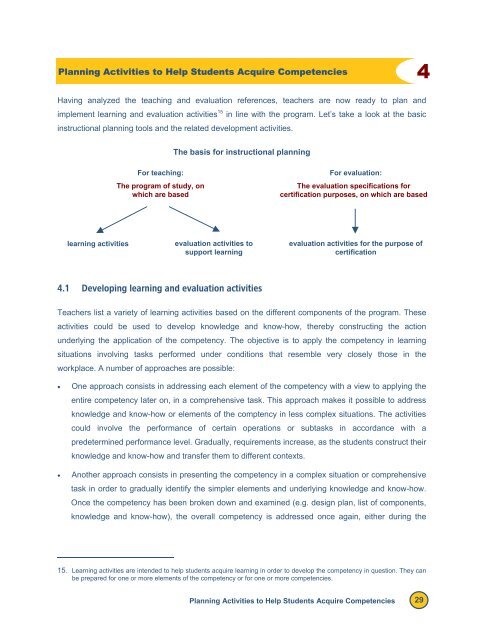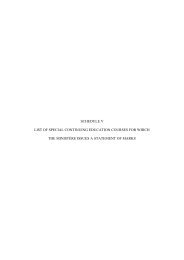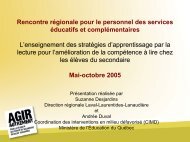Reference Framework for Planning Learning and Evaluation Activities
Reference Framework for Planning Learning and Evaluation Activities
Reference Framework for Planning Learning and Evaluation Activities
Create successful ePaper yourself
Turn your PDF publications into a flip-book with our unique Google optimized e-Paper software.
<strong>Planning</strong> <strong>Activities</strong> to Help Students Acquire Competencies<br />
4<br />
Having analyzed the teaching <strong>and</strong> evaluation references, teachers are now ready to plan <strong>and</strong><br />
implement learning <strong>and</strong> evaluation activities 15 in line with the program. Let’s take a look at the basic<br />
instructional planning tools <strong>and</strong> the related development activities.<br />
The basis <strong>for</strong> instructional planning<br />
For teaching:<br />
The program of study, on<br />
which are based<br />
For evaluation:<br />
The evaluation specifications <strong>for</strong><br />
certification purposes, on which are based<br />
learning activities<br />
evaluation activities to<br />
support learning<br />
evaluation activities <strong>for</strong> the purpose of<br />
certification<br />
4.1 Developing learning <strong>and</strong> evaluation activities<br />
Teachers list a variety of learning activities based on the different components of the program. These<br />
activities could be used to develop knowledge <strong>and</strong> know-how, thereby constructing the action<br />
underlying the application of the competency. The objective is to apply the competency in learning<br />
situations involving tasks per<strong>for</strong>med under conditions that resemble very closely those in the<br />
workplace. A number of approaches are possible:<br />
• One approach consists in addressing each element of the competency with a view to applying the<br />
entire competency later on, in a comprehensive task. This approach makes it possible to address<br />
knowledge <strong>and</strong> know-how or elements of the comptency in less complex situations. The activities<br />
could involve the per<strong>for</strong>mance of certain operations or subtasks in accordance with a<br />
predetermined per<strong>for</strong>mance level. Gradually, requirements increase, as the students construct their<br />
knowledge <strong>and</strong> know-how <strong>and</strong> transfer them to different contexts.<br />
• Another approach consists in presenting the competency in a complex situation or comprehensive<br />
task in order to gradually identify the simpler elements <strong>and</strong> underlying knowledge <strong>and</strong> know-how.<br />
Once the competency has been broken down <strong>and</strong> examined (e.g. design plan, list of components,<br />
knowledge <strong>and</strong> know-how), the overall competency is addressed once again, either during the<br />
15. <strong>Learning</strong> activities are intended to help students acquire learning in order to develop the competency in question. They can<br />
be prepared <strong>for</strong> one or more elements of the competency or <strong>for</strong> one or more competencies.<br />
<strong>Planning</strong> <strong>Activities</strong> to Help Students Acquire Competencies 29




